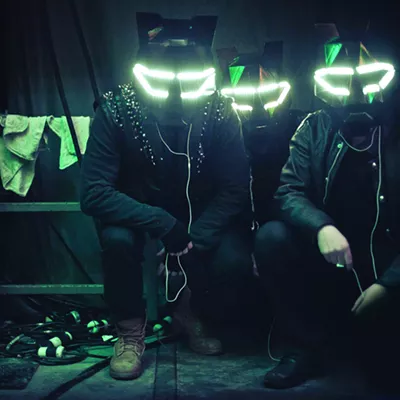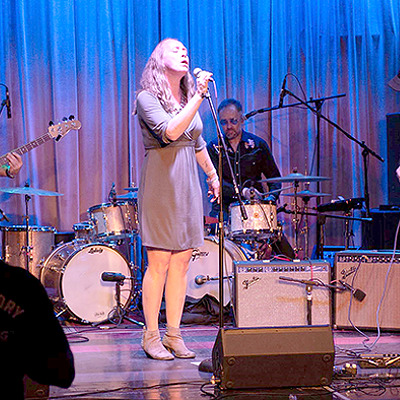But they have at least one goal in common: giving voice to Latina women's lives through dance.
Their dances--about female matadors, a professor, an old women, a prostitute, an Aztec punk warrior--dispel rigid ideas outsiders have about Latinas, at the same time that they subvert narrow conceptions of Hispanic dance.
"Latinas in dance are stereotyped as doing flamenco or capoeira or folklorico," says Eva Tessler, a Tucsonan and member of the project. "A lot of Latina women are working in contemporary dance, but they're submerged."
At the Latina Dance Project's two Embodying Borders concerts in Tucson this weekend at Pima College, the media-mixing work will be contemporary and cutting-edge. (In addition to the concerts, the dancers will offer free master classes. See the info box.) But the performers, each of whom does a separate solo, often rework the traditional dance idioms that are part of their cultural heritage.
Flamenco will be on the program, for instance. But Licia Perea, a native of New Mexico now living in Los Angeles and artistic director of the troupe Danzantes, will dance it unconventionally in "Orlando," a piece inspired by Virginia Woolf's novel about a gender-changing character. Perea will dance in drag, and she'll metamorphose from a gypsy to matador to a transsexual moving through the air on a trapeze.
Brazilian Eluza Santos, a professor of dance at the University of North Carolina at Greensboro, will incorporate elements of Brazilian dance into "Broken Seashell." The movements, though, will be part of a larger modern-dance examination of life on both sides of a cultural divide. On a stage literally split by a "border," she'll deliberately juxtapose different gestures to embody her different lives. Her American, professorial self will be represented by "clear-cut, defined movement," Tessler says, and her more easygoing Brazilian self will be conveyed through "undulating movement." (Santos also does another, shorter piece, "Geni and the Zeppelin," a narrative dance about a prostitute who saves a town.)
Tessler is a choreographer, director, Tucson High dance teacher and possessor of two UA master's programs, in theater arts and anthropology. She also serves as artistic associate of Borderlands Theater, which is presenting Embodying Borders as part of its regular season. In her work, "Unfinished Business," she mixes performance art, modern dance and spoken word, set to music by singer Lila Downs, who, like Tessler, is a native of Mexico. The five-part work jumps genre boundaries.
"Two sections are theater, where I speak. One is purely dance. One is performance art, with newspapers. One is a little old lady, myself as an old woman. It's autobiographical. Some of the stories are about my family. The spoken word is 'Spanglish,'" an amalgam of Spanish and English readily understood by monolingual speakers of either.
Juanita Suarez, Ph.D., and child of migrant workers, will do a gender-bending improv, "Darkey," about an Aztec warrior-turned-punk in 21st-century El Norte. Suarez, an "incredible jazz singer," according to Tessler, will mix song, dance and spoken word, and wear a funny costume. Like Perea, Suarez dances her piece as a man.
"All of our work is very different, but there's a certain unity," says Tessler. Two of the project's members are immigrants to the United States, and two are native-born, but "we have had similar experiences in the United States."
Tessler, of Mexico, and Santos, of Brazil, have both gone through the difficult process of adapting to a new place.
"What we share is coming here, having to learn a new language, having to learn a new culture," says Tessler. Santos uses the broken seashell in her piece as a metaphor for cultural displacement, "for being Latina in the United States, for being unappreciated," Tessler says.
Though Chicanas Suarez and Perea were born in America, they grew up in a distinctive and sometimes separate subculture. Suarez' cultural leap into the American mainstream from a life among migrant workers is almost as great as Santos' geographic leap from Brazil to the United States. After a childhood spent picking crops, Suarez not only studied at a university but became a modern dancer, a professor--at SUNY Brockport--and the author of a soon-to-be-published book.
"Modern dance is the last thing she could (have been expected to) access. She ended up in a university," Tessler says. "That's unusual. Her cultural identity is very contradictory."
Perea has won two NEA choreographers' fellowships and a City of Los Angeles Performing Arts Fellowship. She grew up in a traditional community in Albuquerque but also went on to the university, where she got a master's in choreography and performance. Perea was familiar with flamenco dance, and eventually began subverting its conventions, "doing it in drag, pushing boundaries."
The four already had some connections before they started the Latina Dance Project in Greensboro last year. Suarez was writing about Perea and Tessler's work for a book on Chicana modern dance, and Suarez and Santos knew each other from college. Additionally, Tessler and Santos had known each other years before in Brazil, where Tessler danced, choreographed and taught in the 1980s.
"Eluza (Santos) does multicultural dance in Greensboro, and she invited us to do a concert there and a residency," Tessler says.
It was so successful that the four began tossing around ideas about creating an organization to carry the project forward. They were debating about who they should approach to set it up, Tessler says, when they realized the four of them were the obvious candidates.
Since then, the Latina Dance Project has performed at numerous campuses in the United States, from UC Riverside to Texas Woman's University to SUNY Brockport. The response, Tessler says, has been exhilarating. A student in Texas told Tessler after the concert that the performances captured the feelings she had as a girl in Mexico but added, "I never thought I could say it--nobody would care."
And that student is not the only one. Many women come up after the concerts and tell the four performers that in the characters portrayed in the dances, "I recognize myself."














